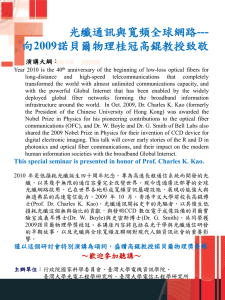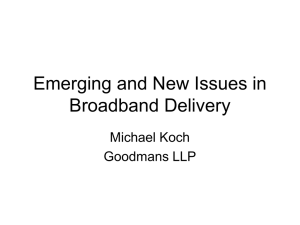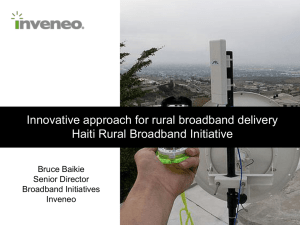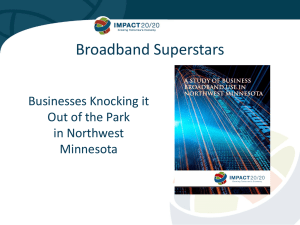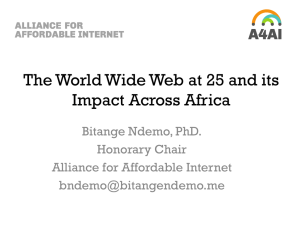RAIN-Tvaronavicius-Budapest
advertisement
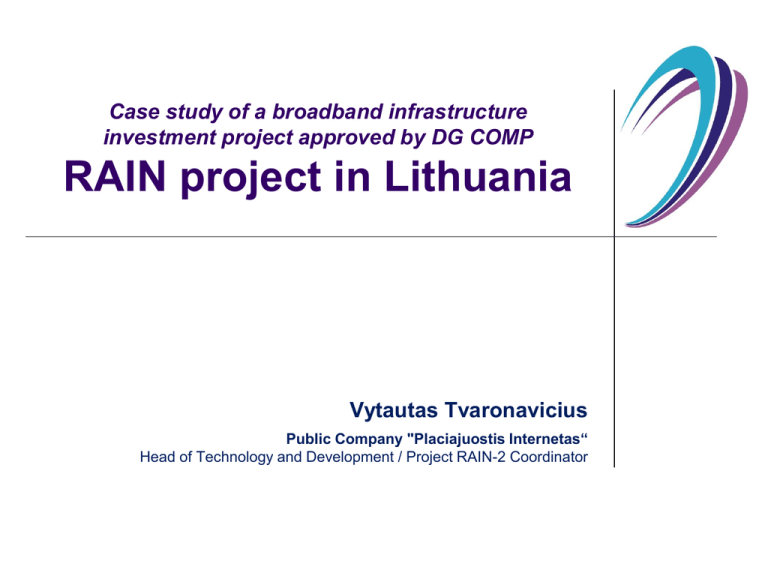
Case study of a broadband infrastructure investment project approved by DG COMP RAIN project in Lithuania Vytautas Tvaronavicius Public Company "Placiajuostis Internetas“ Head of Technology and Development / Project RAIN-2 Coordinator Broadband Penetration Rate 40.0 35.0 30.0 25.0 20.0 15.0 10.0 5.0 0.0 Broadband penetration rate in 2010 in EU-27 countries, by per cent. Why is Lithuania Lagging? Densely populated areas of Lithuania (major cities, especially Vilnius): these areas have sufficient demand for broadband services, and users have sufficient purchasing power -> result: effective competition between broadband service providers. Rural areas of Lithuania: townships are geographically scattered, so the necessary initial investments in rural areas are much higher than in cities, and the inhabitants of rural areas have generally a lower income and thus are unable to pay for the actual costs of the service -> result: broadband access operators are not interested in investing and providing broadband services in such areas. Circumstances of the Project In order to induce development of broadband, Lithuanian authorities decided to justify public intervention to construction of broadband infrastructure in rural, or “white”, areas. It was decided to support the construction of infrastructure in rural areas of Lithuania which are currently not served and where are no plans for coverage in near future. It would be available to all operators on non-discriminatory terms (they will provide broadband services to end users). The main goal of the project RAIN is to help eliminate edivide of broadband infrastructure between cities and rural regions, to increase social cohesion and contribute to economic growth by achieving these goals. Project Development Stages Rural Area Information Technology Broadband Network (RAIN-1) Implementation period: 2005 – 2008. Development of Rural Area Information Technology Broadband Network (RAIN-2) Implementation period: 2009 – 2013. Project RAIN-1: Facts RAIN-1 was implemented by four partners: The Institute of Mathematics and Informatics; Public company “Placiajuostis internetas”; The Ministry of Transport and Communications; The Ministry of Education and Science. 3357 kilometers of fiber optical lines were built; 509 network nodes were installed; 467 elderates were connected to 51 municipality; Value of the project: 21 million EUR. Project RAIN-1: Results Broadband services are available by RAIN network: 330 schools 467 elderates More than 300 000 inhabitants RAIN connection nodes RAIN access nodes RAIN-1 fiber optical lines Rented fiber optical lines Not Connected Villages Rented infrastructure RAIN infrastructure Kaniukai Connected elderates Skudutiškis Runionys Not connected villages with > 200 inhabitants 300 (7) Aučėnai Dapkūniškiai Klabiniai Šakiai Alanta 350 (4) Naujasodis Perkaliai Padvariai Sidabrinės Svobiškės Tijūniškės Kašeikiai Suginčiai Čivyliai Trumponys 240 (5) Verbiškės Pašekščiai Gečiai Kulionys Drąsėnai Avilčiai Balninkai Vorėnai 700 (6) Laičiai 350 (4) Gėliogailiai Juodėnai Girsteikiškis Gilužiai Žiūrai Nosėnai Kuršiškiai Šnieriškės Budriškės Toliejai Levaniškiai 260 (4) Bimbirai Purvėnai 220 (0) Ažubaliai 220 (1) Kijėliai Sodėnai Varniškiai Stirniai Šeštokiškė Molėtai Videniškiai Mindūnai Kirneilė Luokesa Stalėriškiai Kertuoja 280 (5) Inturkė Skrebuliai Pusnė Bekupė Gališkės Bebrusai Žalvariai Pagaluona Ambraziškiai Miežonys Bijutiškis 240 (10) 280 (3) Juozapava 260 (7) Alkūnai Žeimiai Ūta Maldžiūnai Burnėnai Žaugėdai Murališkiai Piliakiemiai Giedraičiai Sarailiai Šakališkės Surgėnai Gačkiškiai Graužiniai Joniškis Rudokai Miežoniai Dubingiai 250 (4) Arnionys 2 Arnionys 1 Vilniaus raj. Project RAIN-2: Presumptions Different operators have developed sufficient "last mile" infrastructure in large part of country's territory. The main reason preventing development of high quality broadband services to all rural residents and organizations – the missing part of the network infrastructure, sufficient bandwidth aggregation part which combines operators’ infrastructure segments. Installation of missing parts requires huge investments. Also installing separate infrastructures they would be unprofitable and inefficiently utilized. Project RAIN-2: Facts RAIN-2 is being implemented by two partners: The Ministry of Transport and Communications; Public company “Placiajuostis internetas”. Scope of the project: Optical fiber lines 4400 km Residential areas 770 Operators’ towers ~ 850 Fixed operators’ POPs ~ 380 Education institutions ~ 570 Libraries ~ 580 Public internet centers ~ 360 Other objects ~ 220 Value of the project: 50,13 million EUR. RAIN connection nodes RAIN access nodes RAIN-1 fiber optical lines Rented fiber optical lines RAIN connection nodes RAIN access nodes RAIN-1 fiber optical lines RAIN-2 fiber optical lines Rented fiber optical lines Broadband coverage after RAIN 2 implementation The key principles The open access principle: the built infrastructure may be employed by all service users. Technical solutions must allow ensuring this principle. Technological neutrality: the selected technologies should allow all potential users of the network to use the resources of the network freely without restrictions to technical solutions. The selected solutions must optimally promote development of a competitive environment, i.e. the end user should be allowed to freely choose the service provider and services. The infrastructure is constructed only in areas where it does not exist. The selected technical solutions should serve long-term and meet the needs for a period of at least 10 years. Infrastructure/service management model RAIN Network Services: •Transmission service via optical fibers 1 2 •Transmission service via multiplexed optical fibers •The service of data transmission 3 4 5 1. RAIN network will be owned by the State. Ministry of Transport and Communications owns it, sets services and tariffs. 2. Public company “Placiajuostis internetas” – supervisor of RAIN network. 3. Maintenance of RAIN network is executed by private sector entities selected via public tenders. 4. Users of RAIN network – all retail operators (on equal conditions, i.e. without any restrictions, or tenders). 5. End users can freely choose retail operator, services and last mile technology according to their needs. Thank you! Questions, comments: vytautas@placiajuostis.lt
